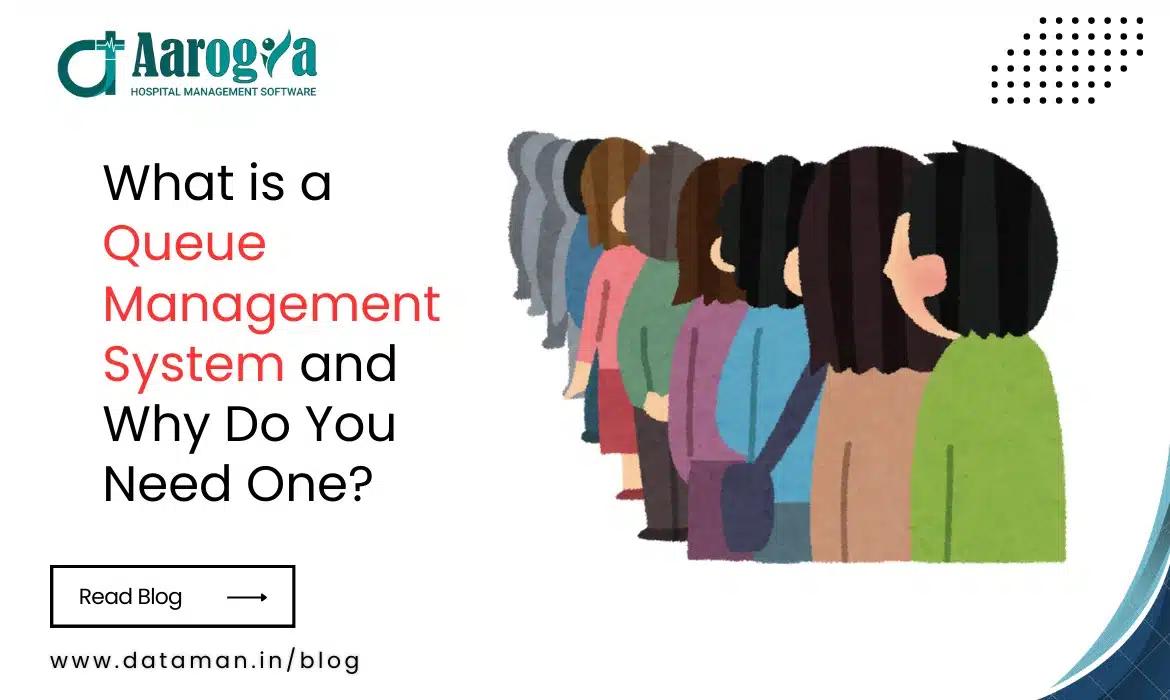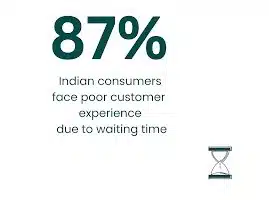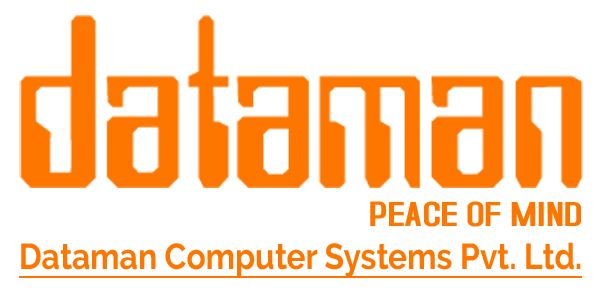- +91 9511117684
- shweta@dataman.in

Table of Contents
Post Views: 15,679
With a population that exceeds 1.3 billion, service areas are often crowded, especially hospitals. They struggle to manage long queues and improve customer experience as waiting in long queues can quickly turn a positive customer experience into a frustrating one. This leads to missed business opportunities and damage to the brand’s reputation. Infact, 87% of Indian consumers consider waiting time a crucial factor in their overall customer experience.

This is where a Queue Management System (QMS) comes in.
What is Queue Management System
Let’s first discuss how big is the queue problem in India?
It’s big. A study by the National Health Authority of India in 2020-21 revealed that outpatient waiting time in public hospitals can stretch over 2 hours.

Such conditions not only frustrate patients but also require extra efforts from medical staff, reducing their productivity. Alright, so what exactly is a queue management system?
At its core, Queue management system (QMS) is a powerful software solution designed to manage and reduce waiting times in various service areas. The system is a game-changer for the hospitals, banks and government offices that typically see large influxes of customers during working hours.
By implementing an efficient QMS, businesses can organize and optimize their customer flow, providing a seamless experience from the moment customers walk in until they leave.
In simple words, the system is like a digital conductor for your waiting room. Where customers register themselves upon arrival. Then, the system assigns a ticket number and provides an estimated wait time based on the current queue. They receive an sms-alert before their turn for service.
In India, the adoption of QMS is on the rise. With a compound annual growth rate (CAGR) of 5.5%, India stands as the third-largest revenue generator for QMS in the Asia-Pacific region.
How does a queue management system works
The working of the queue management system can be divided into several steps as given below. Basically, the system helps customers by providing them a structured process.
- Customer Arrival: A customer arrives at the service location e.g. hospitals, or banks.
- Registration: The customer gets a token or number using a ticket dispenser, kiosk, or mobile app.
- Queue Management: Each customer has a unique token number and the system assigns a queue position and displays the estimated wait time. It may also collect customer information for service prioritization.
- Service Call: When a service agent becomes available, the system alerts the next customer in line, either through a display screen, audio call, or a mobile app notification.
- Service Delivery: The customer receives service from the designated agent.
- Feedback and Data Collection: The system may offer the option for customers to provide feedback on their experience in general with the services offered at Hospital/Bank/Restaurant.
Types of Queue Management Systems
There are different types of QMS available, suited to specific needs and business environments. Here’s a breakdown of some common options:
|
Sr. |
Queue Type |
Description |
Ideal For |
|
1. |
First-come, first-served |
Classic queue system |
General check-ups |
|
2. |
Priority Queuing |
Urgent cases |
Patients requiring immediate attention |
|
3. |
Appointment Queuing |
Scheduled consultations |
Planned appointments |
Priority Queuing
In some cases, the customer requires immediate services irrespective of their arrival time. The best example of this can be seen in hospitals where a patient with a critical condition is in the priority queue.
Unlike a standard queue where patients are served in the order of arrival, a priority based queue management system ensures patients with higher priority are attended before lower priority or normal ones.
In priority queuing, each customer in the queue is assigned a priority level which can be decided based on different factors like urgency, potential impact or predefined service level agreements (SLAs).
The system identifies the priority level and prioritizes the patients.
Aarogya’s Approach to Manage General and Priority Queuing
Aarogya is a comprehensive hospital management software system having a special module for queue management. The system has been designed to handle two types of queues: Regular/General queue and priority queue.
In the regular queue the system functions like FIFO (First-In-First-Out) queue. The patients are prioritize on the basis of their arrival time.
On the other hand, in priority queue, the system assigns priority level to each customer. Based on the condition and situation of the customer they are divided into four priority levels i.e. emergency, high, normal, low. Patients go for consultation as per their priority level.
Aarogya defines a clear priority classification system where it is clearly defined what constitutes an emergency, high priority, normal and low priority in the healthcare context.
System has some predefined rules based on symptoms or vitals of the patient. Apart from that, a nurse evaluates the patient’s condition and assigns their priority.
What’sApp and SMS integration feature in Aarogya System helps patients to know the queue system and priority levels. For better cooperation, hospitals can also use display systems or announcements.
Methods to manage the queues in any organization
- Ticket Dispensing Systems: These traditional systems dispense physical tickets with a queue number. They are simple to use and reliable, but can feel impersonal.
- Kiosk-based Systems: Customers interact with a self-service kiosk to join the queue, select service types, and access additional information. This option offers more flexibility and can handle multiple queues simultaneously.
- Virtual Queuing Systems: Customers join the queue remotely using a mobile app. This eliminates the need for physical presence until their service time approaches. It’s ideal for scenarios where wait times are unpredictable or customers prefer waiting remotely.
- Web-based Queuing Systems: Similar to virtual queuing, customers join the queue through a web interface on their computers or smartphones. This is a convenient option for situations where mobile app installation is not preferred.
Appointment Scheduling Systems: While not strictly a queue management system, appointment scheduling integrates with QMS to manage pre-booked appointments alongside walk-in queues.
But why should you consider a queue management system for your hospital or business? Here are some benefits.
Benefits of Implementing a Queue Management System
Improved Customer Experience: Reduced wait times, real-time updates, and a more organized process lead to a more positive customer experience.
Increased Customer Satisfaction: Happier customers are more likely to return and recommend the business.
Enhanced Staff Efficiency: Streamlined workflows and reduced congestion allow staff to focus on delivering excellent service.
Data-Driven Decisions: QMS data helps identify areas for improvement, optimize staffing levels, and make informed decisions about service processes.
Reduced Operating Costs: Improved efficiency can lead to cost savings in areas like staffing and service delivery.
Increased Revenue: Satisfied customers are more likely to spend more, and reduced wait times can lead to increased customer throughput.
Improved Brand Image: A well-managed queue reflects a professional and customer-centric organization.
The Integration
Queue management systems are generally small software solutions for specific work. The system can be integrated with existing softwares like Hospital management software, EMR/EHR software, Radiology Software and more. It is recommended to have an integrated system with existing solutions as it has several enormous benefits for both patient and healthcare providers.
Aarogya’s Role and Importance
Aarogya acts as a central hub managing queues for various departments and doctors. The system ensures that all patients are directed to their respective doctor efficiently.
The system collects data on various parameters like queue length, wait times, patient flow etc. These reports can be analyzed to identify bottlenecks and optimize the resource allocation. The reports and insights are very useful to improve the overall queue management effectiveness.
Aarogya is a complete hospital management solution. The EMR/EHR module in the system can facilitate access to a patient’s medical history to assign priority to the patient in the queue. Also, the module tracks and manages doctor schedules to ensure appointments and walk-in patients are for available doctors.
QMS integration with HMIS allows for patient information sharing, appointment management, and potentially automated queue placement based on the urgency.
Patients can schedule appointments online or through the system. It reduces the in-person wait time. Patients can also join queues remotely/virtually.
Also Read: Clinic Management System: A Quick Guide For Busy Doctors
Connect With Us
So, we have discussed the queue management system in-detail. For any query or suggestion please contact us.
0

